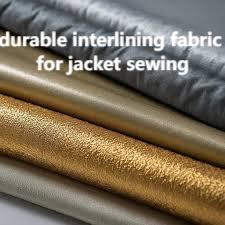-
Fil d’actualités
- EXPLORER
-
Pages
-
Groupes
-
Evènements
-
Blogs
Understanding the Role and Value of Interlining in Modern Apparel

In garment production, Interlining plays a subtle yet essential role in shaping the quality and performance of clothing. Acting as an inner layer between the outer fabric and the lining, Interlining ensures that garments retain their intended form, structure, and feel over time. This hidden textile layer is often overlooked by consumers, yet it is a foundation of durability and professional finishing in the apparel industry.
Enhancing Garment Structure and Longevity
One of the primary functions of this layer is to provide structural support to garments, especially in areas like collars, cuffs, waistbands, and front panels. By reinforcing these sections, clothes maintain their appearance after repeated wear and washing. This internal support is particularly vital for formal attire, outerwear, and work uniforms, where shape retention and crisp presentation are essential.
Material Varieties and Applications
This fabric layer comes in a variety of constructions, each suited for different garment types. Woven options offer stability and strength, ideal for heavy materials. Non-woven types provide flexibility and lighter weight, making them suitable for everyday apparel. Knitted variations are valued for their stretch properties, which benefit sportswear and active garments that require flexibility without compromising form.
Role in Fashion and Function
While it is widely recognized in tailoring, its applications extend beyond formalwear. Casual garments, athletic apparel, and protective clothing all benefit from this inner layer. It can improve comfort by adding a softer feel to certain areas, contribute to temperature regulation in outerwear, and support technical features in performance garments.
Precision Manufacturing and Quality Standards
Producing this fabric layer involves careful control over thickness, adhesion, and durability. Manufacturers use specialized machinery to ensure consistent results that meet the demands of fashion designers and apparel brands. Quality control processes help verify that every batch adheres to performance standards, ensuring the material performs well throughout a garment’s life cycle.
Moving Toward Sustainability
As the fashion industry shifts toward more sustainable practices, efforts to create eco-friendly alternatives for this textile component are growing. Recycled fibers, biodegradable adhesives, and low-energy production methods are being developed to reduce environmental impact. These advancements not only benefit the planet but also appeal to consumers seeking responsibly produced apparel.For a detailed guide on types, uses, and benefits, visit https://www.interlining-factory.com/news/what-is-interlining-types-applications-and-more.html
- Art
- Causes
- Crafts
- Dance
- Drinks
- Film
- Fitness
- Food
- Jeux
- Gardening
- Health
- Domicile
- Literature
- Music
- Networking
- Autre
- Party
- Religion
- Shopping
- Sports
- Theater
- Wellness


